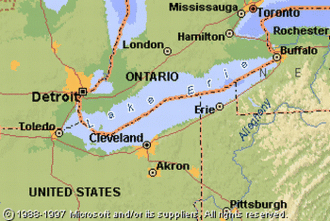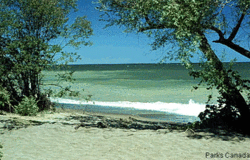Lake Erie, Ontario
| Topics: |
Physical Attributes

- Altitude: 174 m above sea level
- Surface Area: 25,700 sq. km
- Mean Depth: 19 m
- Maximum Depth: 64 m
- Volume: 484 cu. km
- Shoreline Length: 1,400 km
- Drainage Basin: 84,500 sq km
General Description

Lake Erie is Canada's fifth largest lake and is the shallowest of the Great Lakes. The St. Clair River is the major source delivering water from Lake Huron. The Niagara River and the Welland Canal are the main outflows. Lake Erie has three basins with very different characteristics. The shallow Western Basin has a maximum depth of 5-10 m. It is eutrophic, has a high turbidity due to resuspended sediments, and has a productive fishery. The Central Basin is the largest basin and has a maximum depth of approximately 20 m. This mesotrophic area of the lake has a narrow hypolimnion that is often deficient of oxygen. The Eastern Basin is the deepest of the three basins. Although it is oligo/mesotrophic, it appears to have a high nutrient status because of the abundant growth of attached algae along the shorelines. Lake Erie is frequently in the path of storms producing seiches that can increase the water level up to 2.5 m at the downwind end of the lake. The lake is also notorious for producing waves with heights over 5 m. Lake Erie differs from the other Great Lakes because it often completely freezes over during the winter.
Lake Erie has had major pollution problems. The discovery of the role of phosphorus loading in the eutrophication of Lakes Erie and Ontario led to the 1972 Canada / United States Great Lakes Water Quality Agreement. Another concern was the high mercury concentrations in fish caught in the 1970's. Although contaminant inputs into the lake have been greatly reduced, concentrations are still high in the sediments. Despite this, Lake Erie fish often have the lowest contaminant loads in the Great Lakes. The Lake Erie fishery is dominated by yellow perch, walleye, smelt and white bass.
Watershed
The drainage basin of Lake Erie contains some of the richest agricultural land in North America. The Central Basin's glacially-deposited sandy soils are easily eroded and are the source of much of the sediment in the lake. Over 13 million people live in the Lake Erie watershed. The extensive tracts of Carolinean forest and wetlands that once occurred along the shores of Lake Erie have mostly been cleared and drained for agricultural and industrial purposes. At present very little of the natural environment remains.